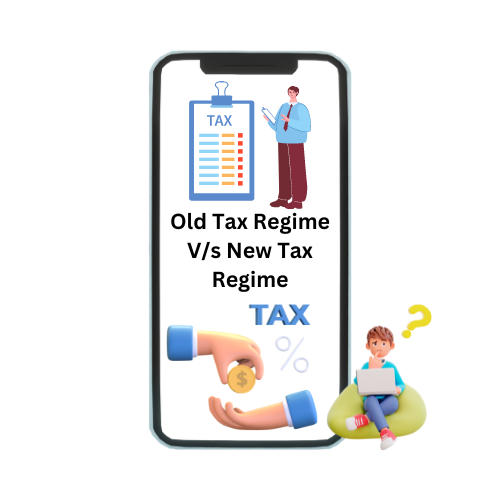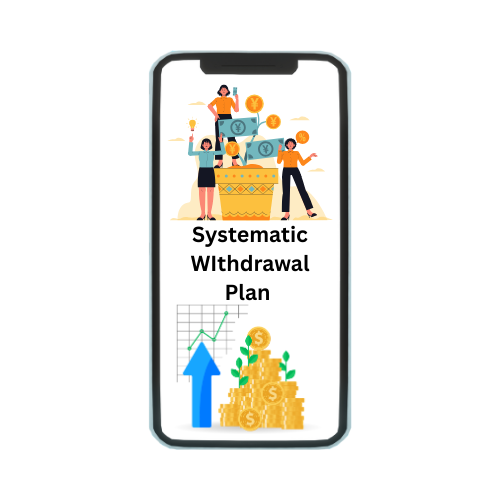OLD TAX REGIME V/S NEW TAX REGIME

Why opt old tax regime when new tax regime is simpler?? Well this question might come cross to you while filing returns. But answer to this question completely depends on your annual income and tax liability. Let us understand how old tax regime and new tax regime differs??
- The old tax regime refers to the income tax structure that was prevalent before the introduction of a new tax regime by the government. In the context of India, for example, there is a conventional tax regime that allows for various deductions and exemptions under different sections of the Income Tax Act. This system provided taxpayers with the flexibility to reduce their taxable income by claiming deductions such as those for investments, insurance premiums, etc.
- In contrast, the new tax regime simplified the tax structure by offering lower tax rates but with fewer deductions and exemptions. Taxpayers are given the option to choose between the old and new tax regimes based on their individual financial situations and preferences. It’s important for taxpayers to evaluate which regime suits them best, taking into account factors such as their income level, investments, and potential tax savings.
OLD TAX REGIME IN INDIA
In India, the old tax regime refers to the income tax structure that allows taxpayers to avail various deductions and exemptions under different sections of the Income Tax Act, 1961. These deductions include allowances for investments, expenses, donations, and other specified payments, which can significantly reduce the taxable income and consequently lower the tax liability.
Key features of the old tax regime in India include:
- Deductions and Exemptions: Taxpayers can claim deductions under sections like 80C (for investments in instruments like PPF, EPF, life insurance premiums), 80D (health insurance premiums), 80G (donations), etc.
- Tax Slabs: There are different tax slabs based on income levels, and tax rates increase with higher income brackets.
- HRA and Other Allowances: House Rent Allowance (HRA) and other allowances are eligible for deductions under specific conditions.
- Investment Incentives: Investments in certain sectors or instruments may qualify for deductions or exemptions.
- Choice Between Regimes: Taxpayers have the flexibility to choose between the old and new tax regimes based on which one suits their financial profile better in a given financial year.
The old tax regime is favoured by those who have substantial deductions eligible for tax exemption, which can significantly reduce their taxable income and overall tax liability. However, the new tax regime introduced in recent years offers lower tax rates but fewer deductions and exemptions, providing an alternative for taxpayers looking for simplicity and reduced compliance burden.
OLD INCOME TAX REGIME SLAB RATE
Old Tax Regime Slabs | Individuals (Age < 60 years) | Resident Senior Citizens (More than 60 but less than 80 years) | Resident Super Senior Citizens (80 years and above) |
Upto Rs 2,50,000 | Nil | Nil | Nil |
Rs 2,50,001 to Rs 3,00,000 | 5% | Nil | Nil |
Rs 3,00,001 to Rs Rs.5,00,000 | 5% | 5% | Nil |
Rs 5,00,001 to Rs 10,00,000 | 20% | 20% | 20% |
Above Rs 10,00,000 | 30% | 30% | 30% |
NEW TAX REGIME
The government, from April 1, 2020 (FY 2020-21), introduced a new tax regime. To enforce this, Section 115BAC was inserted in the Income Tax Act, 1961. The new income tax regime has been made the default tax regime in the Budget 2023-24. However, citizens will continue to have the option to avail the benefit of the old tax regime, said finance minister Nirmala Sitharaman. Also, the Budget 2023-24 has increased the rebate limit in the new tax regime to Rs 7 lakh.
BUDGET 2024-25: TAX SLAB UNDER NEW REGIME
Tax slab under new regime before Budget 2024-25
Total Income | Rate of tax |
Upto Rs 3 Lakhs | Nil |
From 3,00,001 to 7,00,000 | 5% |
From 7,00,001 to 10,00,000 | 10% |
From 10,00,001 to 12,00,000 | 15% |
From 12,00,001 to 15,00,000 | 20% |
Above 15,00,000 | 30% |
New tax regime: Key features
- Salaried employees will save up to Rs 17500 annually in taxes as per the changes proposed in the recent Union Budget 2024-25. The tax slabs have also changed in the new tax regime
- The standard deduction for salaried employees is proposed to increase from Rs 50000 to Rs
- Deduction on family pension for pensioners is proposed to be increased from Rs 15000 to Rs 25000
- The government raised the deduction limit for employer’s contribution to the National Pension System from 10% to 14%.
- NPS Vatsalya is soon to be started plan for contribution by parents and guardian for minors. On attaining the age of minority the plan can be converted into a normal NPS account.
Changes in New Tax Regime
- The new income tax will be default tax regime. This means income will be taxed as per new tax regime slab automatically until a person himself chooses for old tax regime.
- The basic exemption limit has been hiked from 2.5 lakhs to 3 lakhs in the new tax regime.
- A standard deduction of Rs 50000 was introduced under the new tax regime for salaried and individuals who get pensions.
- Under the new tax regime, family pensioners can also claim a standard deduction of Rs 15000.
- The highest surcharge rate of 37% reduced to 25% in the new regime.
- Rebate under Section 87A increased to taxable income of Rs 7 lakh (Tax Rebate of Rs 25000) from Rs 5 lakh (Tax Rebate of Rs 12500)
Tax Slabs for Domestic Companies
The income tax slabs for domestic companies are as follows-
Particulars | Existing or Old Regime Tax Rates | New Regime Tax Rates |
Company opts for section 115BAB (not covered in section 115BA and 115BAA) & is registered on/after October 1, 2019 and has started manufacturing on/before 31st March 2023 | – | 15% |
Company opts for Section 115BAA , where the total income of a company has been calculated without claiming specified deductions, exemptions, incentives, and additional depreciation | – | 22% |
Company opts for section 115BA registered on/after March 1, 2016, and is in the manufacture of any article or thing and does not claim a deduction as specified in the section | – | 25% |
Turnover/gross receipt of the company is less than Rs. 400 crores in the previous year | 25% | 25% |
Other Domestic Company | 30% | 30% |
Surcharge applicable for companies-
- 7% of Income tax where total income is more than Rs 1 crore
- 12% of Income tax where total income is more than R
- 10 crores
- 10% of income tax where domestic company opted Section 115BAA and 115BAB
- Additional Health & Education Cess Rate – 4%
Conditions for Opting for the New Tax Regime
The taxpayers who have opted for the new regime cannot avail some deductions and exemptions that are available in the old regime of taxation which are as follows.
- Leave Travel Allowance
- Conveyance allowance
- House Rent Allowance
- Relocation allowance
- Children education allowance
- Professional tax
- Daily expenses in the course of employment
- Helper allowance
- Deduction under Chapter VI-A deduction (80C,80D, 80E etc.) (Except Section 80CCD(2))
- Standard deduction on salary
- Interest on housing loan (Section 24)
- Other special allowances (Section 10(14))
Common Deductions that are allowed under New Tax Rate Regime
- Investment in Notified Pension Scheme under section 80CCD(2)
- Conveyance allowance for expenditure incurred for travelling to work
- Depreciation under Section 32, except additional depreciation
- Deduction for employment of new employees under section 80JJAA
- Any allowance for travelling for employment or on transfer
- Transport allowance for specially-abled people
Old Tax Regime V/s New Tax Regime –Which one to opt for??
There is no straightforward answer to this question yet. The reason is the complex Indian tax regulations.
Here are some steps to determine whether you must opt for the Old or New Regime.
- Calculate all the exemptions: One can claim HRA if living on rent, one of the biggest salary exemptions. Other tax-free components include LTA, food bills, phone bills, etc. All these will become taxable if you shift to the new tax regime. Here one can get the Standard Deduction by default in the Old as well as the new Regime.
- Look at deductions: In the Old Regime, there are numerous deductions like those available under Section 80C, home loan interest paid, and suchlike. In the New, you won’t get any deductions.
Now, combine these exemptions and deductions and subtract them from your salary to find out your taxable income and what it would be if you let go of these deductions. This should be the deciding factor between the new and old tax regimes.
For the middle class, the finance minister raised the standard deduction — a flat deduction from the total salary earned by an employee in a year before calculating the applicable income tax rate — by 50 per cent to ₹75,000 and tweaked tax slabs for taxpayers opting for the new income tax regime. For those who earn less than ₹7 lakh, the new tax regime can bring down their tax outgo to zero. A salaried employee earning up to ₹7.75 lakh will not have to pay any taxes at all under the new tax regime, due to the higher deduction of ₹75,000. In summation, for those with a higher deduction with a fairly high income are expected to favour the old tax regime, while those with an income of up to ₹7 lakh, and over ₹5-6 crore are expected to favour the simplified regime.
Let us consider an Example
Here Amit has salary of Rs 5.50 lakhs and he avails no deduction and exemptions except for standard deduction. For such a salaried person the tax outgo under both the schemes is zero
Scenario 1
| Old Tax Regime (With HRA) | Proposed New Tax Regime |
Gross Salary | 5,50,000 | 5,50,000 |
Interest deduction on housing loan(Self occupied) deduction/HRA Exemption | – | – |
Standard Deduction | (50,000) | (75,000) |
Gross Total Income | 5,00,000 | 4,75,000 |
Deduction Under Section 80C | – | – |
Deduction Under Section 80D-Medical Insurance Premium | – | – |
Deduction Under Section 80CCD(1B)-National Pension Scheme | – | – |
Total Taxable Income | 5,00,000 | 4,75,000 |
Tax | 12,500 | 8,750 |
Rebate | (12500) | (8750) |
Surcharge | – | – |
Cess | – | – |
Total Tax | – | – |
Total Deductions/Exemptions | 50,000 | 75,000 |
Consider Scenario 2 where Amit receives salary Rs 7,75,000/- At this salary Amit can avail Rs 50,000 as standard deduction and Rs 50,000 under section 80C In old tax regime and the tax outgo comes up to 49,400. However if he chooses new tax regime his tax liability is zero and he can save Rs 49400. Thus here he should opt for new tax regime.
| Old Tax Regime (With HRA) | Proposed New Tax Regime |
Gross Salary | 7,75,000 | 7,75,000 |
Interest deduction on housing loan(Self occupied) deduction/HRA Exemption | – | – |
Standard Deduction | (50,000) | (75,000) |
Gross Total Income | 7,25,000 | 7,00,000 |
Deduction Under Section 80C | 50,000 | – |
Deduction Under Section 80D-Medical Insurance Premium | – | – |
Deduction Under Section 80CCD(1B)-National Pension Scheme | – | – |
Total Taxable Income | 6,75,000 | 7,00,000 |
Tax | 47,500 | 20,000 |
Rebate |
| 20,000 |
Surcharge | – | – |
Cess | 1,900 | – |
Total Tax | 49,400 | – |
Total Deductions/Exemptions | 100,000 | 75,000 |
Consider scenario 3 where Amit earns Salary of Rs 20,00,000 , here he can avail deductions and exemptions like housing loan, HRA under section 80C and overall deductions up to 4 lakhs under the old tax regime . But as per new tax regime he is saving Rs 26000/-
| Old Tax Regime (With HRA) | Proposed New Tax Regime |
Gross Salary | 20,00,000 | 20,00,000 |
Interest deduction on housing loan(Self occupied) deduction/HRA Exemption | 2,00,000 | – |
Standard Deduction | (50,000) | (75,000) |
Gross Total Income | 17,50,000 | 19,25,000 |
Deduction Under Section 80C | 150,000 | – |
Deduction Under Section 80D-Medical Insurance Premium | – | – |
Deduction Under Section 80CCD(1B)-National Pension Scheme | – | – |
Total Taxable Income | 16,00,000 | 19,25,000 |
Tax | 2,92,500 | 2,67,500 |
Rebate | – | – |
Surcharge | – | – |
Cess | 11,700 | 10,700 |
Total Tax | 3,04,200 | 2,78,200 |
Total Deductions/Exemptions | 400,000 | 75,000 |
Summary
It is important to note that the scenarios shown in the tables are broadly indicative. Before taking a call on which income tax regime to opt for, or understanding how much you gain by staying in the new tax regime, it is important to do your own salary specific calculations. If the gross income is more than Rs 15.75 lakh, then an individual is better off taking new regime only if the deductions and exemptions available under the old tax regime are less than Rs 4,33,333 (excluding standard deduction).






